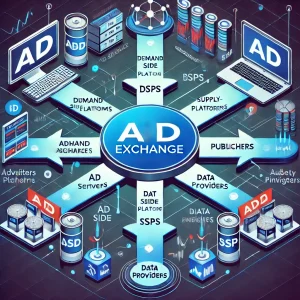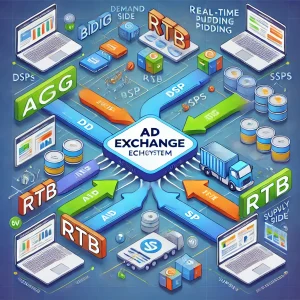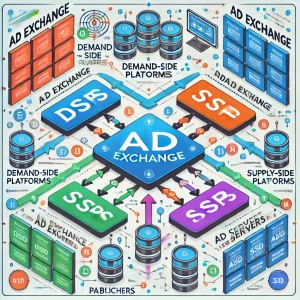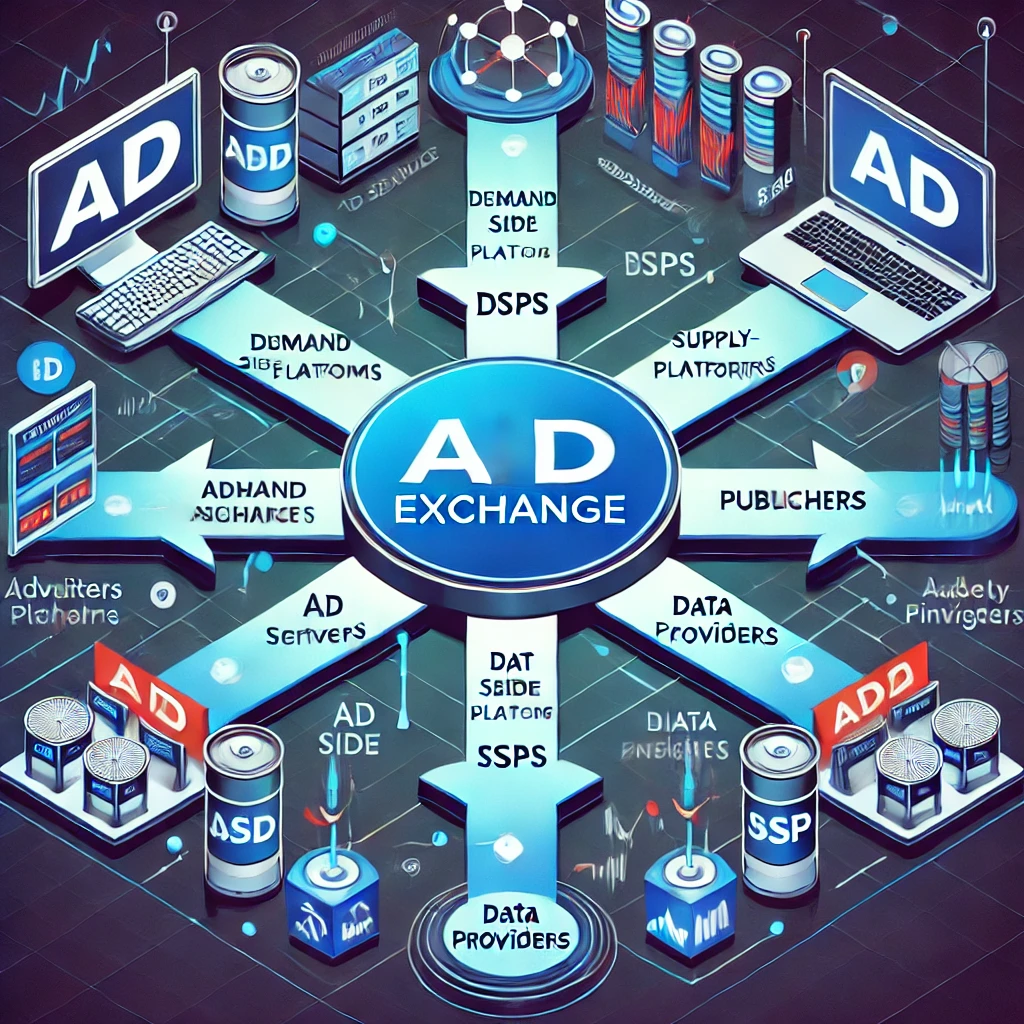Ad Exchanges, Real-Time Bidding and the Ad Ecosystem
In the digital advertising world, ad exchanges play a crucial role. These platforms connect advertisers with publishers in real-time. They serve as digital marketplaces where ad inventory is bought and sold through an automated process. For advertisers, publishers, and intermediaries, understanding ad exchanges is vital for maximizing ad revenue, optimizing ad spend, and improving ad targeting. Here is my last post in these series around Ad Monetization.
[ez-toc]
Contents
What are Ad Exchanges and Their Role in the Ad Ecosystem?
Ad exchanges are platforms that facilitate the buying and selling of ad space in real-time. They enable advertisers to bid on available ad slots from publishers using programmatic advertising. The process occurs within milliseconds and ensures ads reach the most relevant audience.
In the ad ecosystem, ad exchanges are a central hub. They connect demand-side platforms (DSPs) and supply-side platforms (SSPs), allowing for smooth and efficient transactions. This connection is crucial for advertisers looking to maximize ROI and for publishers aiming to monetize their content effectively.
How Do Ad Exchanges Work?
Real-Time Bidding (RTB) is the core mechanism that drives ad exchanges. RTB allows advertisers to bid for ad space in real-time through an auction-based system. The highest bid wins, and the ad gets displayed to the user almost instantly.
Key Players and Technology
- Demand-Side Platforms (DSPs): These platforms represent advertisers. DSPs allow advertisers to bid for ad inventory based on specific targeting criteria.
- Supply-Side Platforms (SSPs): These platforms represent publishers. SSPs help publishers manage and sell their ad space to the highest bidder.
- Ad Servers: These systems deliver ads to the publisher’s site or app once the bidding process is complete. They also track ad performance, including impressions and clicks.
The Bidding Process Explained
- Ad Request: When a user visits a website, an ad request is sent to the ad exchange.
- Bid Request: The ad exchange sends out a bid request to multiple DSPs.
- Bid Response: DSPs analyze the user’s data and decide whether to bid and at what price.
- Auction and Selection: The highest bidder wins the auction, and the ad is served to the user.
- Ad Delivery and Tracking: The ad is displayed, and ad servers track its performance metrics.
Ad Exchange Benfits
Ad exchanges provide multiple advantages to advertisers, publishers, and intermediaries in the digital advertising ecosystem. These benefits help streamline the ad-buying process, improve targeting accuracy, and maximize revenue opportunities. Let’s explore how ad exchanges serve each of these key players:
Advertisers
- Enhanced Targeting Capabilities: Ad exchanges allow advertisers to target specific audiences with precision. Using data from demand-side platforms (DSPs), advertisers can focus on users based on a wide range of criteria, such as demographics, location, browsing behavior, interests, and purchase history. This level of targeting ensures that ads reach the most relevant audience, increasing the chances of engagement and conversion.
- Cost Efficiency and Budget Control: By participating in real-time bidding (RTB) through ad exchanges, advertisers can set budget limits and bid amounts based on their desired cost per acquisition (CPA) or return on ad spend (ROAS). This flexibility allows them to manage ad spend effectively, ensuring they only pay what they consider valuable for each impression or click.
- Improved Ad Performance and ROI: With better targeting and controlled spending, advertisers can optimize their campaigns for higher performance. The ability to test different creatives and placements in real-time allows advertisers to quickly adapt strategies for better results. This leads to a higher return on investment (ROI) as ads are more likely to resonate with the intended audience.
- Access to Premium Inventory: Ad exchanges provide access to a wide range of ad inventory, including premium placements on high-traffic websites. This access allows advertisers to showcase their ads on reputable sites, enhancing brand visibility and trustworthiness.
- Transparency and Insights: Ad exchanges offer detailed reporting on ad performance, including metrics like impressions, clicks, conversions, and viewability. This transparency helps advertisers analyze campaign effectiveness, identify what works, and refine future strategies for even better outcomes.
 Publishers
Publishers
- Maximized Revenue Potential: Publishers use supply-side platforms (SSPs) connected to ad exchanges to sell their ad inventory to the highest bidder. By allowing multiple advertisers to compete for ad space, publishers can drive up prices, resulting in higher eCPM (effective cost per thousand impressions). This competition maximizes revenue opportunities for each impression served.
- Access to a Broader Range of Advertisers: Ad exchanges connect publishers to a vast pool of advertisers. This exposure ensures that even niche websites can attract suitable advertisers, increasing their chances of monetizing their content effectively.
- Improved Fill Rates and Inventory Management: Publishers often face the challenge of unsold ad inventory. Ad exchanges help solve this by filling ad slots with relevant ads from a range of advertisers. This leads to improved fill rates, reducing wasted ad space and boosting overall revenue.
- Enhanced User Experience: By leveraging ad exchanges, publishers can better control the types of ads displayed on their sites. They can filter out low-quality ads and ensure that the ads align with their brand and audience. This improves the user experience, leading to longer site visits and reduced bounce rates.
- Automated Monetization Processes: Ad exchanges automate the process of selling ad space, allowing publishers to focus on content creation and audience engagement rather than manual ad sales. This automation simplifies the monetization process and improves operational efficiency.
Intermediaries (DSPs and SSPs)
- Seamless Integration and Operation: Intermediaries such as DSPs and SSPs are at the core of ad exchanges, facilitating smooth transactions between advertisers and publishers. By leveraging the automated processes of ad exchanges, intermediaries can offer a seamless ad-buying experience.
- Precise Targeting and Optimization: DSPs use sophisticated algorithms and machine learning to analyze vast datasets and optimize bidding strategies. This ensures that ads are served to the most relevant users, improving campaign performance. SSPs benefit from matching high-quality ads to their publisher partners, ensuring effective monetization.
- Higher Value and Efficiency for Clients: By operating through ad exchanges, DSPs and SSPs provide significant value to their clients—advertisers and publishers—through better targeting, efficient ad placements, and competitive pricing. This helps them retain and grow their client base.
- Advanced Data and Insights: Intermediaries benefit from access to extensive data collected through ad exchanges. They can analyze this data to understand trends, optimize future campaigns, and provide more accurate audience insights to their clients.
- Innovation and Differentiation: The evolving landscape of ad exchanges encourages intermediaries to innovate constantly. New bidding strategies, targeting methods, and data integration solutions help DSPs and SSPs differentiate themselves in a competitive market.
Types of Ad Exchanges
 There are two main types of ad exchanges: Open Ad Exchanges and Private Ad Exchanges.
There are two main types of ad exchanges: Open Ad Exchanges and Private Ad Exchanges.
Open Ad Exchanges
Open ad exchanges are accessible to all advertisers and publishers. They provide a wide reach and high competition, which can drive up the value of ad inventory. However, they may come with risks related to ad fraud and brand safety.
Private Ad Exchanges
Private ad exchanges are controlled environments where only invited advertisers can participate. They offer better control, enhanced transparency, and improved brand safety. However, they limit the pool of potential buyers, which can impact competition.
Challenges and Limitations of Ad Exchanges
Despite their advantages, ad exchanges face several challenges:
Ad Fraud and Brand Safety
Ad fraud remains a significant issue in ad exchanges. Fraudulent activities like fake impressions and clicks can waste advertisers’ budgets. To combat this, the industry is adopting measures like ad verification tools and stricter policies.
Brand safety is another concern. In open ad exchanges, ads may appear alongside inappropriate content. Private ad exchanges help mitigate this risk by offering more controlled environments.
Transparency Issues
Hidden fees and lack of transparency can reduce trust in ad exchanges. These issues affect the efficiency of ad campaigns and the overall ad ecosystem. More transparent practices, like fee disclosures and detailed reporting, are needed to build trust.
The Future of Ad Exchanges
The ad exchange landscape is evolving rapidly. Here are some emerging trends shaping the future:
Header Bidding
Header bidding allows publishers to offer ad inventory to multiple exchanges simultaneously before making calls to their ad servers. This approach increases competition and ad revenue for publishers.
Programmatic Direct
Programmatic direct deals provide a more transparent and controlled way to buy ad inventory. These deals offer a middle ground between open auctions and traditional ad buying.
Artificial Intelligence (AI)
AI is increasingly used to improve targeting and optimize bidding strategies in real-time. AI-powered ad exchanges can deliver better results by predicting user behavior more accurately.
Impact on the Ad Ecosystem
As ad exchanges continue to evolve, they will drive greater automation and efficiency in the digital advertising landscape. Advertisers can expect improved targeting and higher ROI, while publishers can benefit from increased revenue opportunities.
AppLixir Rewarded Video Ad
Ad exchanges play a pivotal role in the digital advertising ecosystem. They connect advertisers, publishers, and intermediaries through real-time bidding and programmatic advertising. While they offer many benefits, challenges like ad fraud and transparency must be addressed. Understanding ad exchanges can help optimize digital ad strategies and improve outcomes for all parties involved. Stay informed and leverage ad exchanges to maximize your advertising success.



